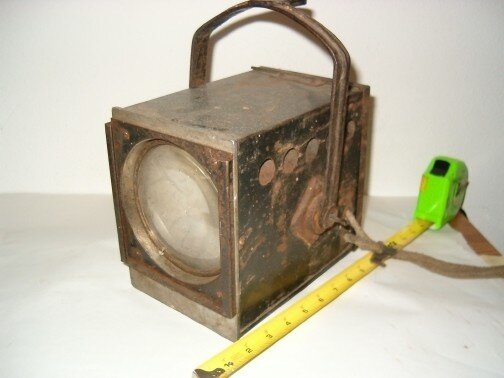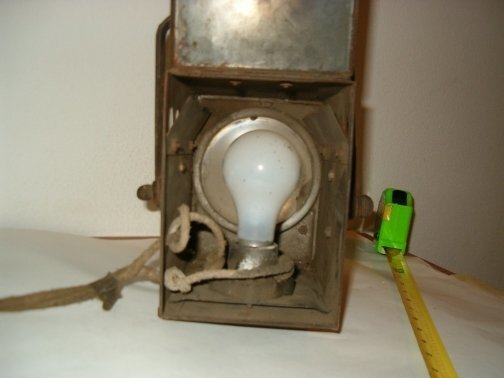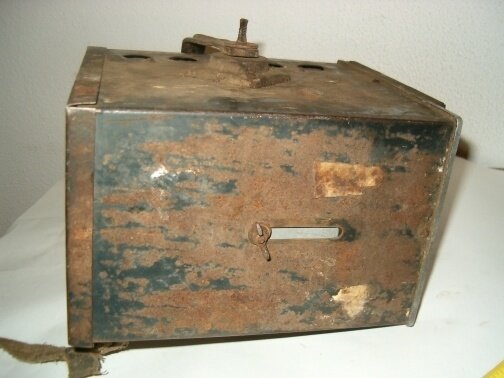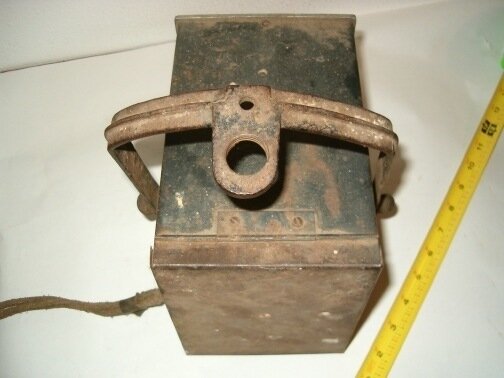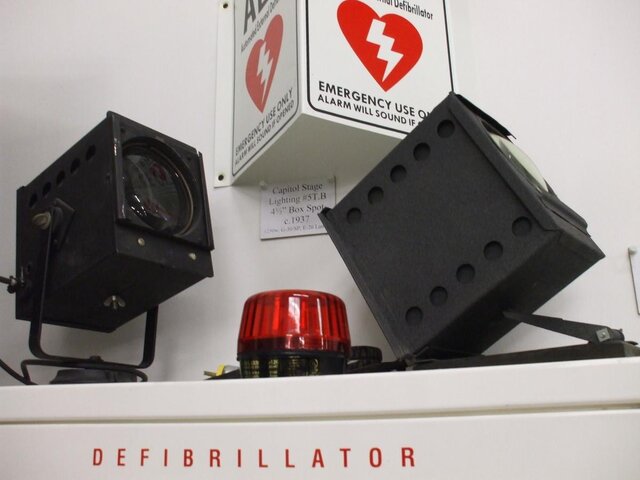Vintage Theatre Spotlight Stage Lighting Old Antique - eBay (item 200537001813 end time Nov-02-10 19:26:30 PDT)
So I did win this scary box spot off E-Bay. Think it's a 1900 - 1920's Capitol fixture by way of hole slots - but pre-the catalogue on our Wiki. Often it's a challenge to figure out in missing or replaced parts how the thing was done. A Century #1590 from between '47 and 62 as narrow as I can refine, in lamp cap assembly I invented for it type of stuff given I had a book with a drawing of it in rough cut-away was helpful. Still have a screw I don't know the purpose of, but it bench focused well today and as good as an Altman 360 with lots less adjustment. Granted also, only like an inch of lens train travel and a lot less than that for bench focus ability.
Anyway, got this box spot off E-Bay, it came with a replacement rear slide back panel. Could tell it was a replacement as it was aluminum plate, and slightly too thick to slide well. It also lacked any way of sliding it by way of handle or knob such a thing would have. Scary about the plate in addition to this, but possible for the times copied in replacement was the hole cut into it's bottom so both the wire could slide out, and by way of pulling that wire as taped to a #6 rayon coated stranded but conduit type non-flexible handle wire, one could focus it. Pull the loop in the wire and the lamp focuses.
So to focus the fixture, you kind of pull on this loop of hard wire attached to the base, and with it, the base wiring slides in and out thru a rough cut hole in the rear plate. Retaining focus was by way of friction against the sides of the fixture in the smaller than normal slide plate that ran that gap between the lower baffle and the screws to mounting the socket riding on the bottom of the fixture. No gide rail for it or real locking mechanism for cord grip or socket assembly.
Assuming that this hole and loop of wire in the base of the fixture with replaced rear cover wasn't what was done, I'm yet to figure out how it was done if different. This in also kind of thinking that perhaps this is one of the origional box spots due to evidence in the fixture construction. Rear slide plate bracket sticks outside of the body of the fixture - yet has the same spot welding as the rest of it. Very unusual a rear slide plate as opposed to a hinged one, this much less, the slide plate or rear cover sticks out further than th rest of the body of the fixture. There is no lower slide groove or even glide plates installed. Really stripped down and basic fixture, yet given the base down globe lamps in use very little to keep it there, and why than the lower cooling vents on the fixture? Or were they perhaps base up lamps for the fixture in using the lower bevel as a glide plate, and gravity? Even still than, nothing really retaning the lamp. Mounting screws to the lamp holder that the bottom of this plate glided on at least were in parallel with the lens and would tend to rock side to side within the fixture for lamp center especially as you focused it.
Stops for that focus was when the globe of the lamp either hit the lens or the back wall of the fixture - that stripped down in any engineering.
Could slide focus either way - though more likely base down mode, and there is like a 3/8" gap between the bottom of the fixture with #6 round head screws gliding along it, and the bottom of the cooling baffle. Enough to throw off the bench focus of for it's time a not so accurate 250w G-30 lamp in reference to the lens? This or expectations of how much quality light the fixture would throw? Don't know. 250w lamp that came with the fixture says "Base down to Horizontal." Why the lower cooling vents, don't know.
So it has no slide mechanism and theoretically, the lower baffle isn't a slide mechanism. It also seemingly glided on the heads of the socket mounting screws - yet I don't see any evidence of that in a pro-longed way. This grated that the #6 wire as wrapped around the rear mounting screw to the socket was larger than the screw heads in making this plate on an angle but explaing why there is no wear from screw heads sliding. Also with gravity perhaps it was on an angle but with gravity flat to the base in three point suspension. Front edge of the lamp glide plate and rear support by way of the hard wire loop pull mechanism. Really crappy way to do it, but no evidence of anything else done.
Next part of scarryest fixture ever done, or worst ever was it's rigging. When I got it, it was like a horse sound effect clapper prop in that the 1x6 (5" wide but old) lumber that had a rounded over bottom had come loose on the front. Walked about the shop with the scarry box spot in using the lumber as a lower jaw in saying Hi! to people. "I'm the most scary fixture ever invented."
People at the shop couldn't figure out what the heck I was pointing out, but this was apparently since origional, some type of table top fixture that sat on a block of wood and was very scarry. What was design verses origional I'm now trying to figure out. Some otherwise possibly later ambitious person - no doubt in re-wiring, replacing the back cover and confusing me now in what else was done, also painted the thing silver and screwed some old school wood screws into it so as to mount the lumber plate under it - or was the lumber origional?
In addition to this, the fixture had some cut off thick plumbers strap - kind of like fender washers in use with 1/4" stove bolts - round head screw with square nut mounted thru one of the rear cooling vents to the fixture. They were not tight, just there as if removed from some way it was later fixed up and rigged. Part of the upper cooling vent was roughly bent away and put back to mount the bolt. Was probably rigged some how and perhaps as a work light in a ceiling somewhere, but not how it will have been rigged, this much less I have no idea of why the lumber it was screwed to wich failed. Intereting also a flat head like #12 wood screw from outside and at the front of the fixture, and from inside it at the rear - easier to punch not drill, like #8 flat head wood screws.
There is no other holes in the fixture for lamp focus slides or how it was rigged if at all. Only thing under the lumber on the bottom of the fixture was rust - a lot of it. No rosette holes to one side or both, nothing in indication for more modern standards for how it was either mounted or how that lamp socket rear slide got done for locking down the bench focus. Possible this fixture did have a wooden base to it, and used three wood screws easily mounted to install it?
This also given the bottom flange of the rear of the fixture plate slide is bent over and spot welded to the base of the fixture. Very strange design for a box spot and given I have two or three different brands of it, by far different than others. So what am I faced with and how do I go about bringing it back to what it was when I don't know what it was or how it worked? How did that glide plate work? How was it rigged if not above a table top?
Final of interesting thing I just noted, the front gel frame is horizontal in bracket. Normally by the 20's for a box spot, they were vertical. This beyond an all steel spot welded fixture that started to go out of style in the 20's though not persay the case with box spots.
No idea of where to go from here in dating it. When for even starting did if Century, they start as a company, or did the box spot and or 400G-30/SP come to the market? When did incandescent fixtures come to the market even? Fuch's don't cover this detail in dating this one that has elements of something really really old.
So I did win this scary box spot off E-Bay. Think it's a 1900 - 1920's Capitol fixture by way of hole slots - but pre-the catalogue on our Wiki. Often it's a challenge to figure out in missing or replaced parts how the thing was done. A Century #1590 from between '47 and 62 as narrow as I can refine, in lamp cap assembly I invented for it type of stuff given I had a book with a drawing of it in rough cut-away was helpful. Still have a screw I don't know the purpose of, but it bench focused well today and as good as an Altman 360 with lots less adjustment. Granted also, only like an inch of lens train travel and a lot less than that for bench focus ability.
Anyway, got this box spot off E-Bay, it came with a replacement rear slide back panel. Could tell it was a replacement as it was aluminum plate, and slightly too thick to slide well. It also lacked any way of sliding it by way of handle or knob such a thing would have. Scary about the plate in addition to this, but possible for the times copied in replacement was the hole cut into it's bottom so both the wire could slide out, and by way of pulling that wire as taped to a #6 rayon coated stranded but conduit type non-flexible handle wire, one could focus it. Pull the loop in the wire and the lamp focuses.
So to focus the fixture, you kind of pull on this loop of hard wire attached to the base, and with it, the base wiring slides in and out thru a rough cut hole in the rear plate. Retaining focus was by way of friction against the sides of the fixture in the smaller than normal slide plate that ran that gap between the lower baffle and the screws to mounting the socket riding on the bottom of the fixture. No gide rail for it or real locking mechanism for cord grip or socket assembly.
Assuming that this hole and loop of wire in the base of the fixture with replaced rear cover wasn't what was done, I'm yet to figure out how it was done if different. This in also kind of thinking that perhaps this is one of the origional box spots due to evidence in the fixture construction. Rear slide plate bracket sticks outside of the body of the fixture - yet has the same spot welding as the rest of it. Very unusual a rear slide plate as opposed to a hinged one, this much less, the slide plate or rear cover sticks out further than th rest of the body of the fixture. There is no lower slide groove or even glide plates installed. Really stripped down and basic fixture, yet given the base down globe lamps in use very little to keep it there, and why than the lower cooling vents on the fixture? Or were they perhaps base up lamps for the fixture in using the lower bevel as a glide plate, and gravity? Even still than, nothing really retaning the lamp. Mounting screws to the lamp holder that the bottom of this plate glided on at least were in parallel with the lens and would tend to rock side to side within the fixture for lamp center especially as you focused it.
Stops for that focus was when the globe of the lamp either hit the lens or the back wall of the fixture - that stripped down in any engineering.
Could slide focus either way - though more likely base down mode, and there is like a 3/8" gap between the bottom of the fixture with #6 round head screws gliding along it, and the bottom of the cooling baffle. Enough to throw off the bench focus of for it's time a not so accurate 250w G-30 lamp in reference to the lens? This or expectations of how much quality light the fixture would throw? Don't know. 250w lamp that came with the fixture says "Base down to Horizontal." Why the lower cooling vents, don't know.
So it has no slide mechanism and theoretically, the lower baffle isn't a slide mechanism. It also seemingly glided on the heads of the socket mounting screws - yet I don't see any evidence of that in a pro-longed way. This grated that the #6 wire as wrapped around the rear mounting screw to the socket was larger than the screw heads in making this plate on an angle but explaing why there is no wear from screw heads sliding. Also with gravity perhaps it was on an angle but with gravity flat to the base in three point suspension. Front edge of the lamp glide plate and rear support by way of the hard wire loop pull mechanism. Really crappy way to do it, but no evidence of anything else done.
Next part of scarryest fixture ever done, or worst ever was it's rigging. When I got it, it was like a horse sound effect clapper prop in that the 1x6 (5" wide but old) lumber that had a rounded over bottom had come loose on the front. Walked about the shop with the scarry box spot in using the lumber as a lower jaw in saying Hi! to people. "I'm the most scary fixture ever invented."
People at the shop couldn't figure out what the heck I was pointing out, but this was apparently since origional, some type of table top fixture that sat on a block of wood and was very scarry. What was design verses origional I'm now trying to figure out. Some otherwise possibly later ambitious person - no doubt in re-wiring, replacing the back cover and confusing me now in what else was done, also painted the thing silver and screwed some old school wood screws into it so as to mount the lumber plate under it - or was the lumber origional?
In addition to this, the fixture had some cut off thick plumbers strap - kind of like fender washers in use with 1/4" stove bolts - round head screw with square nut mounted thru one of the rear cooling vents to the fixture. They were not tight, just there as if removed from some way it was later fixed up and rigged. Part of the upper cooling vent was roughly bent away and put back to mount the bolt. Was probably rigged some how and perhaps as a work light in a ceiling somewhere, but not how it will have been rigged, this much less I have no idea of why the lumber it was screwed to wich failed. Intereting also a flat head like #12 wood screw from outside and at the front of the fixture, and from inside it at the rear - easier to punch not drill, like #8 flat head wood screws.
There is no other holes in the fixture for lamp focus slides or how it was rigged if at all. Only thing under the lumber on the bottom of the fixture was rust - a lot of it. No rosette holes to one side or both, nothing in indication for more modern standards for how it was either mounted or how that lamp socket rear slide got done for locking down the bench focus. Possible this fixture did have a wooden base to it, and used three wood screws easily mounted to install it?
This also given the bottom flange of the rear of the fixture plate slide is bent over and spot welded to the base of the fixture. Very strange design for a box spot and given I have two or three different brands of it, by far different than others. So what am I faced with and how do I go about bringing it back to what it was when I don't know what it was or how it worked? How did that glide plate work? How was it rigged if not above a table top?
Final of interesting thing I just noted, the front gel frame is horizontal in bracket. Normally by the 20's for a box spot, they were vertical. This beyond an all steel spot welded fixture that started to go out of style in the 20's though not persay the case with box spots.
No idea of where to go from here in dating it. When for even starting did if Century, they start as a company, or did the box spot and or 400G-30/SP come to the market? When did incandescent fixtures come to the market even? Fuch's don't cover this detail in dating this one that has elements of something really really old.
Last edited:



